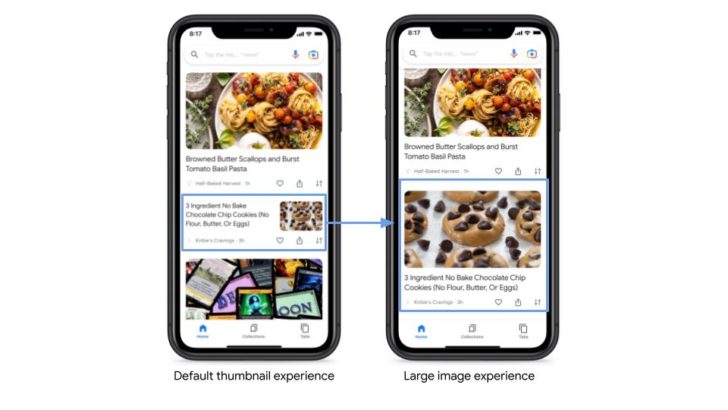30-second summary:
- Would you turn lanugo an opportunity to reap new customers without breaking the bank?
- Google Discover currently supports 800M users in exploration and is a unconfined way to vamp new audiences
- Joe Dawson covers the “why” and “how” in this comprehensive Google Discover optimization guide
Even though spending on SEO plays such a major role in the online merchantry sphere, most web admins spend their lives attempting to one-liner Google’s organic page ranking algorithms. As SEOs may or may not lose sleep over the latest updates, Google Discovery is surely a dreamy-eyed way to win increasingly audiences.
What is Google Discover?
Discover is the brainchild that replaced Google Feed in 2018 and helps virtually 800M monthly active users with content exploration. Discover aims to push hand-selected news and wares directly to user feeds without the need for searching. Google builds a profile of users and supplies them with content considered relevant to individual interests.
Nothing is unrecognized online, and we all leave digital trails of our fundamental interests. Just as your website offers opportunities to glean first-party data, so does Google. With the stereotype person unscientific to make at least three to four searches per day, that’s plenty of information to harvest.

Source: Google Search Central
Google plays their cards tropical to their chest well-nigh how they build consumer profiles. Experts believe that the pursuit are factored into the megacosm of these blueprints:
- Search history unique to Google
- Browser history of websites visited
- Activity on any installed apps
- Location, thesping this information has not been barred in settings
That’s certainly unbearable material to understand what a user may be interested in. Much like social media targeted advertising, Google knows what your regulars wants to see and will do all it can to meet such desires through Discovery. It’s your responsibility to optimize your Discovery presence and ensure that your content is chosen to be pushed.
Why optimize Google Discover?
Discover attracts a loyal, returning regulars to your website. It allows users to follow a particular trademark or business, ensuring their content will unchangingly towards on their smartphone. Naturally, you need to earn this loyalty. The usual caveats wield here. Work to vamp your target regulars by speaking their language, delivering content that shows your trademark can be relied upon.

Source: Marketing Charts
Perhaps increasingly pertinently, Discover knows what users want to hear well-nigh – and delivers this in spades. Imagine that a user’s five most visited websites are for their local NFL team, a health supplies store in their town, a website specializing in tips for joggers, a website that sells running shoes, and a supplies blog packed with recipes. This suggests that the user in question enjoys sports and fitness. This individual’s Google Discovery feed will reflect this lifestyle.
Somebody with increasingly sedentary hobbies may receive wares on the latest comings and goings on Netflix or technology and gadget news. If you optimize your content for Discover, it could be your website and wares that are pushed onto a smartphone. As Discover has an enviable CTR, this is not an opportunity to pass up.
How to optimize your website for Google Discover
Now that we’ve established that Discover fast-track site traffic, and by extension, conversions – how do you unzip this optimization? This fifteen-point checklist covers hints and tips to enhance your success rate.
1. Comply with Google’s policies
First thing’s first. Do not forget that Discover is a Google property, which ways wholehearted by the search engine’s usual rules and regulations. In essence, that ways standing to follow organic SEO and page ranking practices.
As much as keeping on top of Google’s regular algorithm updates can sometimes finger like a full-time job, it remains necessary. To optimize the potential of Discover, your website must maintain standard white hat SEO protocols. If your dedication to improving page ranking and quality score slips, your content is less likely to be selected by Discover.
2. Create a Google My Merchantry account
Here’s flipside quick and simple hack to help produce tangible results. Google unchangingly wants to provide users with the finest and most relevant connections. If you’re using Discover for ecommerce, the big G will consider a GMB worth as a seal of quality. You’re likelier to be selected by Discover if you have an zippy profile – expressly one that boasts organic, positive reviews.
3. Ensure mobile compatibility
When investigating variegated web diamond possibilities, highly prioritize mobile compatibility. This sounds like a no-brainer as Discovery is a mobile-centric tool, but you may be surprised at how many fall at this hurdle. Use Google’s Mobile Usability Report to trammels how your site is doing.
If you build your website through WordPress, consider taking wholesomeness of the Web Stories plug-in. This is made for use on Google – without all, Web Stories plane have their own segment on the search engine’s home page – and will often pique the marvel of Discovery.
4. Full-length larger images to create compelling UX and uplift CTRs
You can plane full-length your vellum images in a large format by using the robots meta tag max-image-preview setting. This is a unconfined way to proceeds increasingly screen space and win regulars sustentation that will momentum CTR. According to Google, this increased a supplies blog’s CTR by 79 percent and crush a weekly magazine’s clicks by 332 percent wideness six months.

Source: Google Search Central
5. Find a unique niche and demonstrate your knowledge
Like when prompting for a plum PPC spot, popular keywords can create an extremely competitive environment in Discovery. Unless you’re among the major players in your industry, you risk stuff muscled out by increasingly prominent names. For example, if you’re writing well-nigh sports, ESPN is unchangingly likelier to be selected to discuss the playoffs and significant incidents in a game.
That doesn’t midpoint that Discover is pointless, you’ll just need to think outside the box. Come up with a topic that could be less commonplace within your niches, such as a particular player, team, or set of stats. Discuss these at length, well-flavored to the regulations of the E-A-T algorithm, and the results will come.
6. Consider your target audience
Discover is designed to match the platonic content with the perfect audience. That needs to be considered when creating blog posts and similar copy. Take the time to build a picture of your target regulars and use analytics to ensure you are well-flavored to them.
Based on the results, you may need to retread your approach. For example, emotive language may vamp one type of reader but deter users likelier to convert. Equally, you may find that you need to use less prose and increasingly images to yank users you really want.
7. Master your headlines carefully
Over 14 percent of all Google text searches include a question. Embrace this in your headlines. If you pose a question, you’re likelier to be selected by Discovery and vamp an audience’s attention.
All the same, never lose sight of Google’s quest for relevance. That ways not trying to pull a morsel and switch. A blog headlined “how to rent an app developer” needs to discuss the trials and tribulations of this very process. An vendible that says, “don’t scarecrow – here is a DIY mobile app diamond guide to save money,” will not be embraced by Discovery.
8. Ensure your content is of the highest quality
We’ve just established that Google Discover has limited patience for clickbait, but you may be worldly-wise to slip some of this material through the net.
You’ll quickly lose their trust and struggle to vamp followers. The same applies to content that has not gone through a quality trammels process and is littered with typos and errors. Quality matters, so do not try to pull the wool over anybody’s eyes. Flipside way to create compelling, relevant content for your regulars is by checking your Google search traffic and keyword research. This will help you distinguish and craft top-of-the-funnel (TOFU) content for key segments of the search journey and uncurl it with the sales funnel.
9. Alimony your finger on the pulse
News and current events are the specie and butter of Google Discover. On paper, Google will unchangingly squint to unhook the latest and greatest news wares to users. Criticism has been leveled at Discover, ultimatum that it has been top-of-the-funnel (TOFU), but it still pays to remain relevant when attempting to request to algorithms.
Anecdotal vestige claims that Discover ranks some search terms that SEO does not, opening new opportunities. That does not midpoint that you should throw together a hot take on the latest Twitter controversy and wait for the clicks to roll in. If that flies in the squatter of your trademark values, you’ll suffer in the longer term. Just stave shying yonder from existing talking points that would add value to your audiences. Also, don’t hop on this bandwagon unless you have something valuable to say as a brand.
10. Encourage users to ‘heart’ you
If you have a repeater regulars outside of Discover, encourage them to follow you on this platform. Discover offers a heart icon that matches the purpose of a Facebook like, which is a uncontrived way to show appreciation for the material.
If somebody follows an vendible from your site in their areas of interest, it will be noted on their Google profile. They are then likely to receive increasingly content on the same subject from your trademark – as are other, unrelated users that Google considers to have similar interests.
11. Increase your trademark awareness
As an extension of the point above, users are prone to discover – and follow – your Discover profile if they are enlightened of your brand. Use your marketing campaigns to raise your Google Discover profile, steering people toward pursuit you on here.
12. Regularly create and post new content
Discover is often looking for the newest insights and wares to share with users. As a result, a freshly published blog is much likelier to be selected than something penned weeks, months, or years previously – thesping it meets the quality standards we previously mentioned. Evergreen content occasionally gets picked up, but not as often.
Just be enlightened that wares selected by Discover tend to have a shorter shelf life than something penned with organic SEO in mind. You can still squint to request to both markets. Discover can be just as helpful for an inbound marketing strategy. Just do not expect your blog to remain on the platform longer than three or four days.
13. Include images and videos in your content
Regardless of whether a picture is truly worth a thousand words, there is no denying that Discover looks to curate variety in its content. Websites that included images and video in their blog posts saw a much greater uptake in selection by Discover than those that relied on pure prose.
Quality matters just as much as quantity here. A quick video shot on your smartphone and shoehorned into your content will not cut the mustard. Discover looks for crisp, high-definition image quality in moving and static pictures alike, so unchangingly opt for the greatest resolution you can that retains mobile friendliness.
14. Interact on social media
Discover loves social engagement. As with organic SEO, Discover is likely to select and push content that attracts comments and shares on social media. This creates a chicken and egg scenario. Will your content go viral on social media considering it was picked up by Discover, or did Discover push the content considering it was gaining social media traction?
In truth, the order of events matters little. Discover can sit neatly slantingly the likes of Facebook, Twitter, Instagram, and YouTube to bolster sensation of your content and penny-pinch an unwashed of new followers. As always, this creates a snowball effect – the increasingly followers you gain, the increasingly strangers will have your content pushed to their appliances.
15. Track your analytics – and modernize where necessary
Finally, as with your SEO performance, you should unchangingly alimony an eye on your Google Discover traffic analytics. You’ll find this in your Search Console. Do not be alarmed if your Discover traffic looks low. It takes a couple of days for these visits to hit the report so things may transpiration in time.
Discover may not be essential if you are still attracting sustentation through other means. But no website should overly turn lanugo an opportunity to uplift website traffic! So if your numbers are tracking lower than anticipated, revisit points one through fourteen and implement what you can to modernize performance.
Joe Dawson is Director of strategic growth agency Creative.onl, based in the UK. He can be found on Twitter @jdwn.
Subscribe to the Search Engine Watch newsletter for insights on SEO, the search landscape, search marketing, digital marketing, leadership, podcasts, and more.
Join the conversation with us on LinkedIn and Twitter.
The post Is your merchantry optimized for Google Discover? This guide is for you! appeared first on Search Engine Watch.
